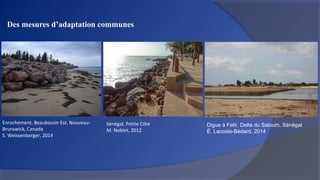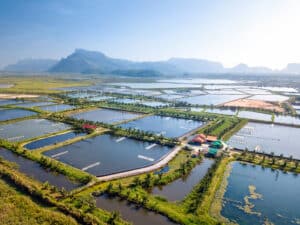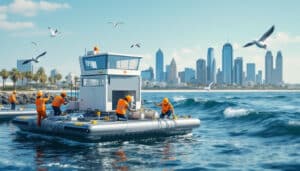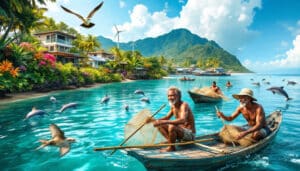Coastal communities, which live to the rhythm of the tides and seasons, face increasingly pressing challenges linked to environmental change. Between rising sea levels, coastal erosion and the intensification of extreme weather events, these regions find themselves at a crossroads. Faced with this reality, residents are implementing innovative and adapted strategies to preserve their way of life and their ecosystems. From protecting infrastructure to adopting sustainable fishing practices, each initiative demonstrates collective resilience and determination to safeguard a future in the face of climate uncertainties. By exploring these efforts, we discover a mosaic of solutions that illustrate the capacity of coastal communities to adapt to contemporary challenges.
| Adaptation | Concrete Examples |
| Water resources management | Installation of rainwater harvesting systems to reduce dependence on fresh water sources. |
| Protecting coastal ecosystems | Restoration of mangroves and dunes to mitigate erosion and protect against storms. |
| Sustainable urban planning | Development of climate-resilient areas, avoiding construction in flood-prone areas. |
| Education and awareness | Programs to inform local communities about the risks of climate change. |
| Use of green technologies | Adoption of solar panels and renewable energy technologies in local infrastructure. |
-
Water management strategies
- Rainwater collection
- Use of natural filtration systems
- Rainwater collection
- Use of natural filtration systems
-
Resilient agriculture
- Cultivation of drought-resistant varieties
- Agroecology practices
- Cultivation of drought-resistant varieties
- Agroecology practices
-
Protection of ecosystems
- Mangrove restoration
- Creation of marine protected areas
- Mangrove restoration
- Creation of marine protected areas
-
Education and awareness
- Workshops for local communities
- Environmental school programs
- Workshops for local communities
- Environmental school programs
-
Sustainable infrastructure
- Storm Resistant Buildings
- Improved drainage systems
- Storm Resistant Buildings
- Improved drainage systems
-
Collaboration and partnerships
- Networks between coastal communities
- Partnerships with NGOs and governments
- Networks between coastal communities
- Partnerships with NGOs and governments
-
Monitoring and research
- Climate change monitoring systems
- Research on environmental impacts
- Climate change monitoring systems
- Research on environmental impacts
- Rainwater collection
- Use of natural filtration systems
- Cultivation of drought-resistant varieties
- Agroecology practices
- Mangrove restoration
- Creation of marine protected areas
- Workshops for local communities
- Environmental school programs
- Storm Resistant Buildings
- Improved drainage systems
- Networks between coastal communities
- Partnerships with NGOs and governments
- Climate change monitoring systems
- Research on environmental impacts
Table of Contents
ToggleAdaptation strategies for coastal communities

Sustainable management practices for maritime resources
THE coastal communities are facing unprecedented challenges due to climate change. To survive and prosper, they adopt varied strategies aimed at strengthening their resilience in the face of environmental disturbances.
The implementation of green infrastructure such as coastal dunes and salt marshes helps reduce the impacts of storms and erosion. These solutions not only provide natural protection, but also contribute to the local biodiversity.
In some regions, the early warning systems and evacuation plans are essential to protect populations from immediate risks. At the same time, education and training of residents on good practices in emergency situations play a key role.
There sustainable management of maritime resources is at the heart of the practices ofadaptation of coastal communities. Responsible fishing, the preservation of marine habitats and the application of quotas are concrete examples of these practices.
- Set up quotas to avoid overfishing
- Create marine protected areas
- Promote selective fishing techniques to minimize bycatch
- Encouraging sustainable aquaculture
Furthermore, the marine agriculture initiatives sustainable are gaining popularity. They offer a viable alternative to traditional fishing while reducing environmental impact. Ethical aquaculture, for example, limits the use of chemicals and ensures the well-being of farmed species.
Finally, the improvement of conservation policies and the promotion of technological innovations play a central role. The projects ofrenewable marine energy such as offshore wind turbines and tidal turbines are developed to provide clean energy while respecting marine ecosystems. Their deployment makes it possible to diversify energy sources and reduce greenhouse gas emissions.
Community initiatives and awareness
THE coastal communities face many challenges due to environmental changes. Adaptation strategies are multiplying and often combine traditional and innovative approaches.
The protection of marine resources and promotion of sustainable practices are among the priorities. This includes taking into account the risks linked to sea level rise
Among the community initiatives, some islands are experimenting with mangrove restoration projects, which act as natural barriers against flooding. Other communities are working to preserve marine biodiversity by creating marine protected areas and promoting sustainable fishing practices.
- Mangrove restorations
- Marine protected areas
- Sustainable fishing
Initiatives to raise public awareness are also essential. Environmental education campaigns and community workshops
A crucial aspect of these efforts is technological innovation. The development of initiatives in blue economy and the implementation of projectsrenewable marine energy enable coastal communities to reduce their carbon footprint while promoting sustainable economic growth.
These multiple efforts demonstrate how coastal communities can proactively adapt, blending tradition and modernity to ensure their resilience in the face of climate change.
Frequently Asked Questions
What are the main environmental threats facing coastal communities? Coastal communities face threats such as rising sea levels, coastal erosion, more frequent and intense storms, and changes in ocean temperature and acidity.
How do coastal communities assess risks from environmental change? They use a variety of methods, including scientific studies, predictive models, and participatory assessments involving residents to identify and assess risks.
What strategies are coastal communities putting in place to adapt to changes? Strategies include building coastal protections, restoring natural ecosystems, sustainable land use planning and educating communities about environmental risks.
What role does technology play in the adaptation of coastal communities? Technology helps improve early warning systems, monitor environmental changes and develop resilient infrastructure.
How do coastal communities involve citizens in the adaptation process? They organize workshops, public meetings and participatory projects to ensure that citizens’ voices are heard and their needs are taken into account.
What are some examples of success in coastal community adaptation? Projects such as restoring mangroves, using living walls for erosion protection, and improving drainage systems are examples of success.
Is there funding available to help coastal communities adapt? Yes, several government and non-government organizations offer grants and funding for coastal adaptation and resilience projects.








